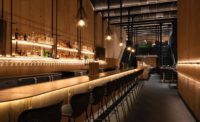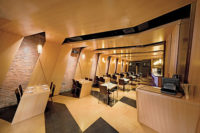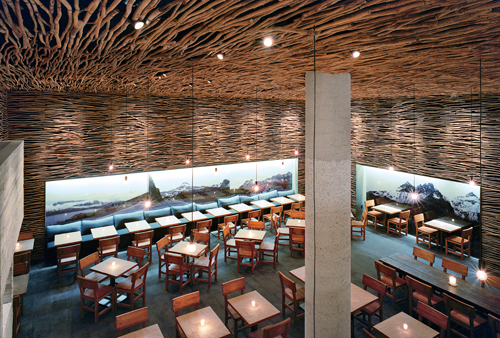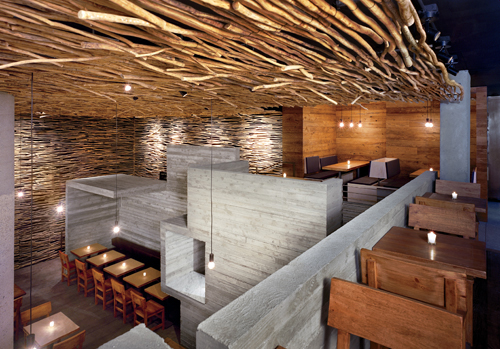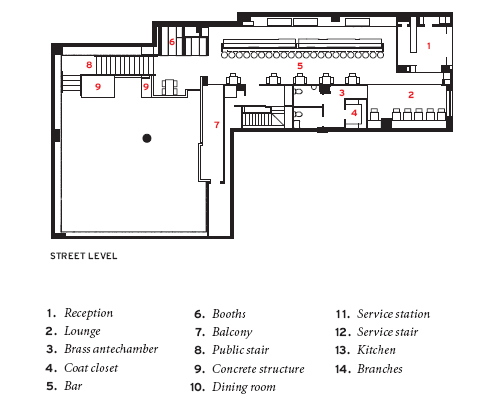Pio Pio Restaurant
San Diego-based Sebastian Mariscal Studio evokes the flavor of Latin America at the Hell's Kitchen outpost of Pio Pio in New York City.

Photo © Paúl Rivera / archphoto.com

Photo © Paúl Rivera / archphoto.com

Photo © Paúl Rivera / archphoto.com

Photo © Paúl Rivera / archphoto.com

Photo © Paúl Rivera / archphoto.com

Photo © Paúl Rivera / archphoto.com

Image courtesy Sebastian Mariscal Studio

Image courtesy Sebastian Mariscal Studio

Image courtesy Sebastian Mariscal Studio









Architects & Firms
Hell’s Kitchen, a gritty, rapidly gentrifying district on Midtown Manhattan’s west side, buzzes with a mix of prewar residential and commercial buildings, Modern towers, hotels, theaters, and shops. Many of the neighborhood’s watering holes embrace its frenetic urbanscape with clear sight lines to the activity outside. But Pio Pio, a new restaurant designed and built by Sebastian Mariscal Studio for a client who owns several local Peruvian eateries, turns away from the street, offering only a glimpse of the transformative space beyond its glass doors.
Located on a busy thoroughfare, the 5,268-square-foot project cuts deep into the two lower floors of a new, aluminum-and-glass, 9-story condominium—next to a donut shop. Wanting to create the aura of Latin America within this context, Mariscal and his eponymous firm devised a “path of travel” that would lead diners away from the street and transport them (at least conceptually) to a different country—in this case, Peru. According to the San Diego–based Mariscal, the idea was to be evocative, not country-specific, a strategy that worked to his advantage when, in mid-project, new clients stepped in and changed the program from a Mexican venue to a Peruvian one. So rather than incorporate the forms and colors associated with one specific place, he explains, “We used the intangible influence of Latin American architecture, which is more about natural materials like stone, wood, and concrete.”
Informed by a seemingly arbitrary configuration of columns and the L-shaped footprint of the existing raw space, the designer developed a series of functional “boxes,” or rooms, connecting them to form a trajectory that begins at the entrance and weaves through the space to the main dining room. The first of the subdivisions, the reception “box” and adjacent lounge, are visible from the street and serve as the restaurant’s chief signage, since the graphics are artfully understated. To beckon passersby, Mariscal layered the containerlike areas with a compelling contrast of textures: Rustic wood planks (from recycled mushroom-bed shelving) compose the floors, walls, and ceilings; slivers of recessed LEDs define the entry’s orthogonal geometry; and a polished Carrara marble desk projects across its center (ostensibly cantilevered from a niche but actually supported by two steel posts underneath one end). Finally, satiny, untreated brass panels radiate a lustrous glow from closet doors flanking the portal into the lounge, as well as from the outer and inner walls of a jewel-like restroom antechamber at the far end of the room.
Mariscal maintained the directional flow by inserting a narrow, hand-chipped concrete walkway along the right side of the lounge and continued it into the 15-foot-wide bar area. To keep things moving, he installed a sleek, 40-foot-long marble counter on one side of the room and backed it with a mural of downlit polycarbonate resin panels featuring photographs of Peruvian street life. Then he erected a wall on the other side, separating the bar area from a newly constructed service stair down to the 1,703-square-foot kitchen. Not one to waste usable space, he carved a fifth small box beyond the bar, where he fit two commodious booths with built-in storage to hold an overflow of coats and bags.
At this juncture, Pio Pio opens onto an airy, double-height volume, situated beneath the building’s roof extension. To create a continuum, Mariscal leveled the entire ceiling to align with the existing lower plane of the concrete extension, tucking the mechanicals in the available plenum over the bar, and painted it black. Then he had his crew build a stone-lined concrete stair to the lower level, where they crafted a stylized, 1,313-square-foot Latin American dining patio—the final box.
To conjure up an alfresco atmosphere, the design team created a more than 15-foot-high envelope made of 4,000 6-foot-long Ocotillo branches—a sustainable Mexican plant that had been dried and de-barked—by attaching them to ½-inch threaded-steel rods anchored to the floor and ceiling. Then they hand-chipped an exposed structural column, so that it appears to be a tree trunk within a courtyard. To mimic the random arrangement of structures found in Latin American towns and cities, the builders fabricated rough concrete walls and enclosures from hand-built two-by-four wood forms—wrapping the stair, shaping a balcony above, and partitioning the service areas. Halogen spots twinkle through the branches like stars, vivid against the black ceiling, and toplit scenes of the Andes line two walls. A matrix of hanging, bare-bulb pendants over simple wood tables helps to establish a cantina ambience.
Like the heroine of the Spanish film Pan’s Labyrinth, customers make their way to the dining room through Mariscal’s boxes with a heightened sense of anticipation, catching limited views of their destination. When they arrive, they forget the streets of New York and soak in the enchanting quality of the place.
Mariscal says that Pio Pio’s limited street frontage helps achieve this air of discovery. “You see very little from the outside. Then you go through the bar and get to the patio with its ilclusion of a tree with branches around you. That is the feeling we wanted to create.”
PeopleArchitect: Personnel in architect's firm who should receive special credit: Architect of record: Project Manager: Interior designer: Engineer(s): Structural: Rizwan Salam Consultant(s): Kitchen and Bar: Polaris Audio: BJR Audio General contractor: Construction Management: Photographer(s): Renderer(s): CAD system, project management, or other software used: |
ProductsStructural system: Exterior cladding: Windows: Glazing: Doors: Metal doors: Garcia and Garcia Construction (custom) Wood doors: Garcia and Garcia Construction (custom) Sliding door hardware: Hafele Hardware: Hinges: Soss Closers: Soss Pulls: Garcia and Garcia Construction (custom) Cabinet hardware: Eurosystems Interior finishes: Suspension grid: Garcia and Garcia Construction (custom) Cabinetwork and custom woodwork: Garcia and Garcia Construction (custom) Paints and stains: Garcia and Garcia Construction (custom) Wallcoverings:Garcia and Garcia Construction (custom) Special surfacing:Garcia and Garcia Construction (custom) Floor and wall tile: Garcia and Garcia Construction (custom)(bathrooms, main dining floor, stairs) Furnishings: Chairs: Reliquias Mexicanas (custom) Tables: Reliquias Mexicanas (custom tops)/ Garcia and Garcia Construction (custom bases) Upholstery:Walter Upholstery (custom) Lighting: Downlights: Contech Task lighting: Contech, Kurtzon (kitchen) Exterior: Winona Plumbing: Hansgrohe; Toto Add any additional building components or special equipment that made a significant contribution to this project:
|


